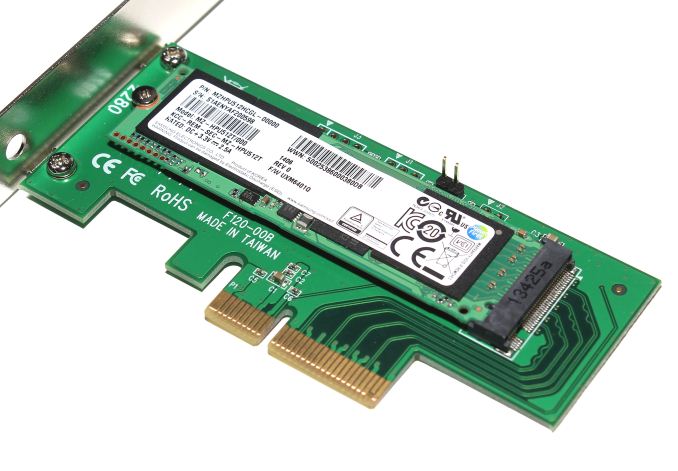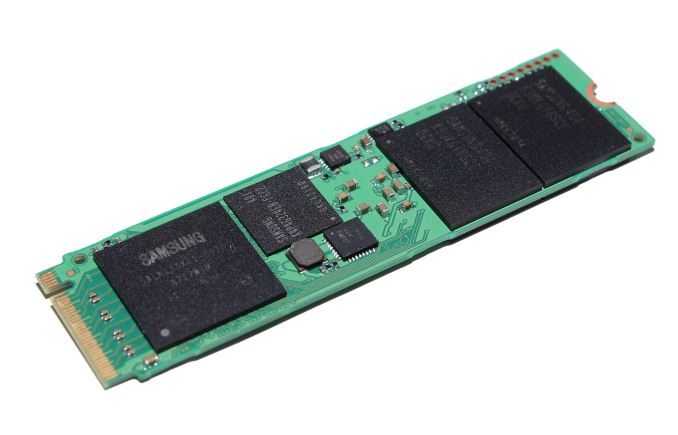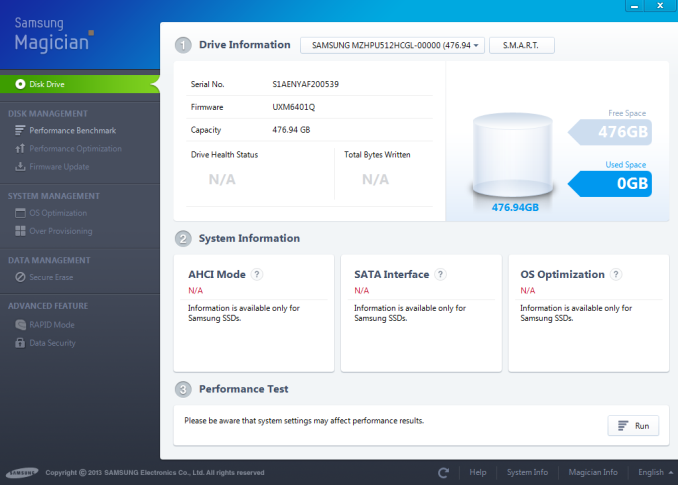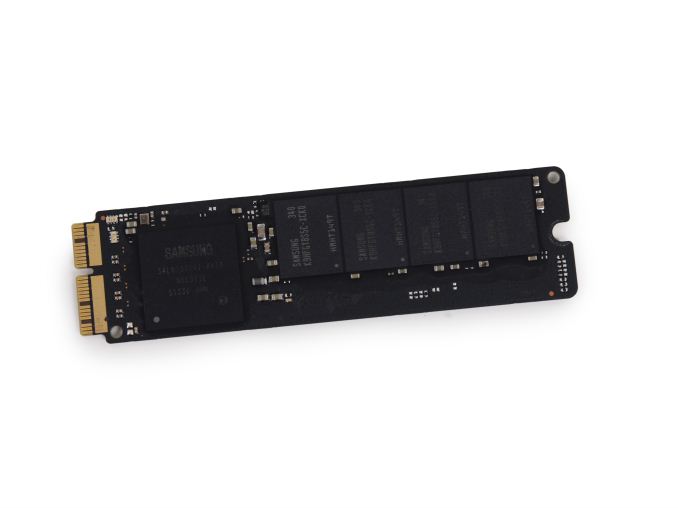Samsung SSD XP941 Review: The PCIe Era Is Here
by Kristian Vättö on May 15, 2014 12:00 PM ESTThe Samsung XP941
In June last year, Samsung made an announcement that they were mass producing the industry's first native PCIe SSD: the XP941. In the enterprise world, native PCIe SSDs were nothing new but in the consumer market all PCIe SSDs had previously just used several SATA SSDs behind a PCIe bridge. Samsung didn't reveal many details about the XP941 and all we knew was that it was capable of speeds up to 1,400MB/s and would be available in capacities of 128GB, 256GB and 512GB. Given that the XP941 was (and still is) an OEM-only product, that wasn't surprising. OEM clients often don't want the components they are buying to be put under a public microscope as it may lead to confusion among their customers (e.g. why isn't the drive in my laptop performing as well as the drive in the review?).
Photography by Juha Kokkonen
The XP941 is available only in M.2 2280 form factor. The four-digit code refers to the size of the drive in millimeters and 2280 is currently the second largest size according to the M.2 standard. Basically, the first two digits refer to the width, which per M.2 standard is always 22mm (hence the 22 in the code) and the last two digits describe the length, which in this case is 80mm. There are four possible lengths in the M.2 spec: 42mm, 60mm, 80mm and 110mm, and the purpose of different lengths is to allow manufacturers to design drives for multiple uses.
The reason for the variable size comes from mSATA, where the issue industry had problems with the fixed size. That's why Apple, ASUS, and others went with custom designs in order to fit more NAND packages on the PCB. I believe 80mm (i.e. 2280) will be the most popular form factor as it's capable of holding up to eight NAND packages but especially drives that are aimed for tablets and other ultra mobile devices may utilize the smaller 2242 and 2260 form factors.
As the XP941 isn't available in retail, Samsung isn't sampling it to media. Fortunately an Australian Samsung OEM retailer, RamCity, was kind enough to send us a review sample. The SSD we received is the highest capacity 512GB model, so we should be able to reach the maximum potential performance. RamCity actually sent us two 512GB drives and I couldn't resist putting the two in RAID 0 configuration in order to see what kind of throughput two drives could offer.
RamCity also sent us a PCIe 3.0 x4 adapter for connecting the drive to our testbed. The adapter in question is a Lycom DT-120, which retails for around $25. There are also other adapters in the market, such as Bplus' dual PCIe 2.0 x4 adapter, but the Lycom is the cheapest I've seen and is likely the best option for the average buyer.
| Samsung SSD XP941 Specifications | |||
| Capacity | 128GB | 256GB | 512GB |
| Controller | Samsung S4LNO53X01 (PCIe 2.0 x4) | ||
| NAND | Samsung 19nm MLC | ||
| Sequential Read | 1000MB/s | 1080MB/s | 1170MB/s |
| Sequential Write | 450MB/s | 800MB/s | 950MB/s |
| 4KB Random Read | 110K IOPS | 120K IOPS | 122K IOPS |
| 4KB Random Write | 40K IOPS | 60K IOPS | 72K IOPS |
| Power (idle / active) | 0.08W / 5.8W | ||
| Warranty | Three years (from RamCity) | ||
The XP941 is based on Samsung's in-house PCIe controller. Samsung isn't willing to disclose any exact details of the controller but I would expect it to be quite similar to the MEX controller found in the 840 EVO, except it utilizes a PCIe interface instead of SATA. The controller supports up to four PCIe 2.0 lanes, so in practice it should be good for up to ~1560MB/s without playing with the PCIe clock settings (it's possible to overclock the PCIe interface for even higher bandwidths). In terms of the software interface, the XP941 is still AHCI based but Samsung does have an NVMe based SSD for the enterprise market. I would say that AHCI is a better solution for the consumer market because the state of NVMe drivers is still a bit of a question and the gains of NVMe are much more significant in the enterprise space (see here why NVMe matters).
NAND wise the XP941 uses Samsung's own 64Gbit 19nm Toggle-Mode 2.0 MLC NAND. There are only four packages on the PCB, two on each side, which means we are dealing with 16-die packages. I'm not sure if Samsung has a proprietary technology for NAND die stacking but at least they seem to be the only manufacturer that is packing more than eight dies in a single package. From what I have heard, other manufacturers don't want to go above eight dies for signal integrity reasons, which directly impacts performance, but Samsung doesn't seem to have issues with this.
Again, no details such as the P/E cycle count are known but I'm guessing the NAND is still rated at the same 3,000 P/E cycles as its 21nm counterpart. Samsung's datasheet doesn't list any specific endurance for the drive, though that makes sense since it's an OEM drive and the warranty will be provided for the whole product (e.g. a laptop) where the drive is used in.
The XP941 shows up in Samsung's Magician software but it's not recognized as a Samsung SSD. This has been typical for Samsung's OEM SSDs as even though they sometimes share the same hardware and firmware as their retail counterparts, the Magician functionality is disabled. It makes sense because PC OEMs often source their drives from more than one SSD OEM, so it wouldn't be fair to buyers if one drive had additional functionality while the other didn't.
The SSD in 2013 Mac Pro - courtesy of iFixit
The XP941 is hardware wise the same drive that you can find inside 2013 Macs, although most of the laptop version are limited to PCIe 2.0 x2 interface. However, the form factor and interface Apple uses are custom and the larger form factor allows for eight NAND packages and thus support for a 1TB model.
Test System
| CPU |
Intel Core i5-2500K running at 3.3GHz (Turbo and EIST enabled) |
| Motherboard | AsRock Z68 Pro3 |
| Chipset | Intel Z68 |
| Chipset Drivers | Intel 9.1.1.1015 + Intel RST 10.2 |
| Memory | G.Skill RipjawsX DDR3-1600 4 x 8GB (9-9-9-24) |
| Video Card |
Palit GeForce GTX 770 JetStream 2GB GDDR5 (1150MHz core clock; 3505MHz GDDR5 effective) |
| Video Drivers | NVIDIA GeForce 332.21 WHQL |
| Desktop Resolution | 1920 x 1080 |
| OS | Windows 7 x64 |
Thanks to G.Skill for the RipjawsX 32GB DDR3 DRAM kit














110 Comments
View All Comments
RamCity - Monday, May 19, 2014 - link
The Lycom M.2 to PCie adapter does a reasonable job with small form factor computers. It has a low-height bracket in addition to the standard height one. Note though, you can't boot the XP941 in any windows PC with one of these adapters as far as we know - it wont show up in the bios as a bootable device. Only in a 2006-2012 Mac Pro under OSX will it be bootable.Rod
Oscarcharliezulu - Monday, May 19, 2014 - link
Nice job anandtech... You detected what country i was reading this from and inserted appropriate text/prices? Great job. Appreciated.kizh - Tuesday, May 20, 2014 - link
still running my sandy 2500k that did 4.8 reliably until I updated bios. I bought a z67 board that had a pcie 3.0 x 16 lane as an early adopter. The only thing worth upgrading on it was the graphics so bought a 780 (on accident thought it was a 780 ti) I spent about 24 hours of my time researching making it work on a early version of uefi and trying multiple set ups. Gonna send it back, its not worth upgrading my whole system for this.Never buying another feature that isn't being used yet, by the time its truly a standard your warranty is over and FU if it got tweaked a little.
Got 2 M2 in raid, no trim ever bothered me. Its fast enough, don't need this. Maybe if a whole system upgrade was as fun as it used to be,
Right now all I see waiting for is a 4k display port standard and some nicer models coming out. I want to throw money at these guys but not for next to nothing,
I'm not rich by any measure but dumped money on tech as a hobbyist.
kizh - Tuesday, May 20, 2014 - link
oh just to clarify I know it would only be pcie 3.0 with ivy, I didn't expect that chip to be such a let down. Still this should have worked at pcie 2.0. Also when I say m2 I'm talking about the model name of my ssd's. not m.2just some clarifications
sfgebrqy - Wednesday, May 21, 2014 - link
I would have bought this in a heart-beat if it weren't for two things:1) Average/bad 4k random read/write
2) Abysmal 4k scaling with QD
The killer feature for this SSD is without a doubt its sequential performance. Compared to any single SSD alone, it blows it out of the water on the benches, whether
practical or synthetic.
The caveat is "single SSD". RAID 0 can always be used to boost sequentials. Maybe not exactly linearly, but close to linearly. Take a look at the review for 2 Samsung 840
Pros in RAID 0 (page 3). I can't link (or even mention the website) it because the comment filter says its spam, so take a guess and use Google. Sequentials are nearly
doubled for both read and write.
The kicker is that this CANNOT be done for random I/O at low QD. Which is to say, if we wanted better random I/O from XP941s, we couldn't RAID them together to do it. In
fact, RAID typically makes random I/O marginally worse at low QD due to overhead. See the aforementioned review (page 4).
RAID does multiply random I/O at high QD, but with XP941 4k QD scaling non-existent to begin with, it's a lost cause.
Even if we did want to RAID XP941s together, I can't seem to find any tests/reviews of more than two at once, let alone a RAID controller capable of putting more than two
M.2 devices in RAID 0. Meanwhile, there are plenty of RAID controllers capable of pushing 16+ SATA3 devices (albeit bottlenecked at x8 PCIe 3.0).
The bottom line is that if I found out that my current SATA3 SSD RAID 0 array wasn't putting out enough sequential, I could just add a few more SSDs to solve the issue. If I
found out that my XP941 array wasn't putting out enough random I/O, there's nothing I could do to fix it.
If you're in the market for single SSDs and your system can handle M.2, then this is the cream of the crop. If you have RAID arrays though, wait until M.2 becomes more
popular and Samsung pushes a new M.2 SSD with better random I/O performance.
skrewler2 - Sunday, May 25, 2014 - link
Sorry late to the party but this part of the article is just ignorant:"Using an SSD as a secondary drive can make sense for e.g. a video professional where the performance can be utilized as a scratch disk, but otherwise the only real use case for an SSD is as a boot drive"
What the hell?
aviv - Wednesday, June 4, 2014 - link
Hey gr8 reviewI got question about the graphs
Its log systemic
Does it means when its lower by 1/10 its just half of the value or
In between its linar
brentpresley - Thursday, July 3, 2014 - link
ASUS just released a new BIOS today (7/3/2014) that allows for M.2 boot support of the XP941.I just installed it and the BIOS can see the XP941 in AHCI mode now.
iBurley - Wednesday, December 3, 2014 - link
If put into the M.2 slot of one of the ASRock Z97 boards mentioned in the review, will this be running at full speed, or would I need an adapter like you tested with to use the full potential of the drive?On ASRock's website, under the port listing for the board, it states "1 M.2 (PCIe Gen2 x2 & SATA, Supports 30mm, 42mm, 60mm, 80mm, 110mm M.2 devices)" but I don't know if that just means the interface or if it would actually go over the PCIe bus instead of SATA.
SERGE 2015 - Tuesday, July 14, 2015 - link
I have AsRock's Z97 Extreme6 and XP941 and it is unfortunately NOT bootable out of the box. As it's been mentioned - once the system boots up using another EFI source, the XP941 becomes visible and can then load whatever been installed on it. This is due to lack of OpROM on XP941. The new Samsung SM951 been declared as "Supports Standard AHCI driver" though.